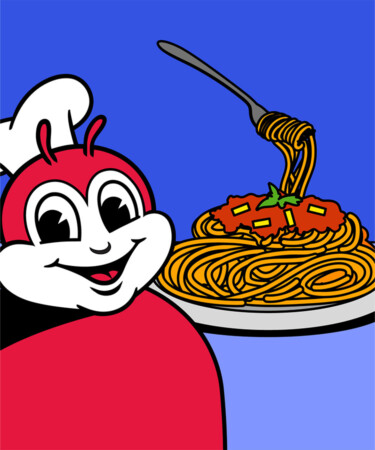This article is part of our Cocktail Chatter series, where we dive into the wild, weird, and wondrous corners of history to share over a cocktail and impress your friends.
Filipino fast-food chain Jollibee is known for its fried chicken, peach mango pies, and, of course, its famous Jolly Spaghetti. The menu item was introduced a year after the chain was founded in Quezon City in 1978, and has held a place in the hearts of customers ever since. It’s both a classic Filipino comfort food and the stuff of some nonna’s would-be nightmares: spaghetti tossed with ground pork, chopped hot dogs, banana ketchup, and sweet peppers, all topped with grated Velveeta cheese. The dish still strikes a delicious chord for many as a childhood staple, a cultural icon, and a stateside reminder of the Philippines. But how did that even happen?
Canned Goodness
In the late 1800s, European traders were sailing the high seas in search of salt and spices. When they got to the Philippines, they introduced the nation to pasta. The years that followed were largely marked by the American colonization of the Philippines, and during that time, American immigrants brought with them canned goods like tomato ketchup. Locals quickly took to the stuff, incorporating it as a condiment in just about everything.
But when World War II hit, these then-beloved canned goods were in short supply. Since the humidity of the islands isn’t conducive to growing tomatoes, residents got crafty and began making the stuff from bananas, a bountiful crop across the nation. The first banana-based ketchup was created in the 1930s by Filipina food technologist and pharmaceutical chemist María Orosa. And though it’s unclear when exactly it started showing up in spaghetti, someone in the late ‘30s or early ‘40s saw a sweet opportunity in those tangled webs of noodles.
Sweet, Sweet Spaghetti
The earliest rumors of sweet spaghetti date back to when General Douglas MacArthur was assigned to be the American Field Marshal of the Philippine army in 1937. While in the Philippines, he supposedly enjoyed a Filipino interpretation of Spaghetti Napolitan (a similar yet savory ketchup-based spaghetti dish from Japan). In 1942, Filipino food chemist Magdalo V. Francisco invested in a factory and began mass-producing banana ketchup domestically. This operation would grow to become the now iconic brand Mafran, which quickly rose to the leading brand of ketchup in the Philippines.
Fast-forward to 1998, and Jollibee opened its first U.S. location in Daly City, Calif. There are now 72 domestic Jollibee locations, most of which are in the Golden State. So whether sweet spaghetti reminds you of your childhood or you’ve never seen the stuff in person, it’s worth finding a Jollibee near you to try the international innovation.
*Image retrieved from Macky Albor via stock.adobe.com
